When an iPad Pro Is Enough: A Computer's Conundrum
VerifiedAdded on 2019/09/16
|14
|5805
|499
Report
AI Summary
Apple's latest iPad Pro is a powerful device that can replace traditional laptops for many users, especially those who only need to perform basic tasks such as Web browsing, note-taking, and video calling. With its A9X processor and 2GB of RAM, the iPad Pro outperforms most laptops in terms of speed and responsiveness. It also features a high-quality display, loud and clear speakers, and a long-lasting battery. However, it lacks some essential features that traditional laptops have, such as multitasking capabilities, a file management system, and USB ports. Additionally, some popular apps may not be optimized for the iPad's iOS operating system. Overall, while the iPad Pro is an excellent device in its own right, it is not necessarily the 'ultimate' PC replacement, but rather a versatile and portable alternative that can meet the needs of many users.
Contribute Materials
Your contribution can guide someone’s learning journey. Share your
documents today.
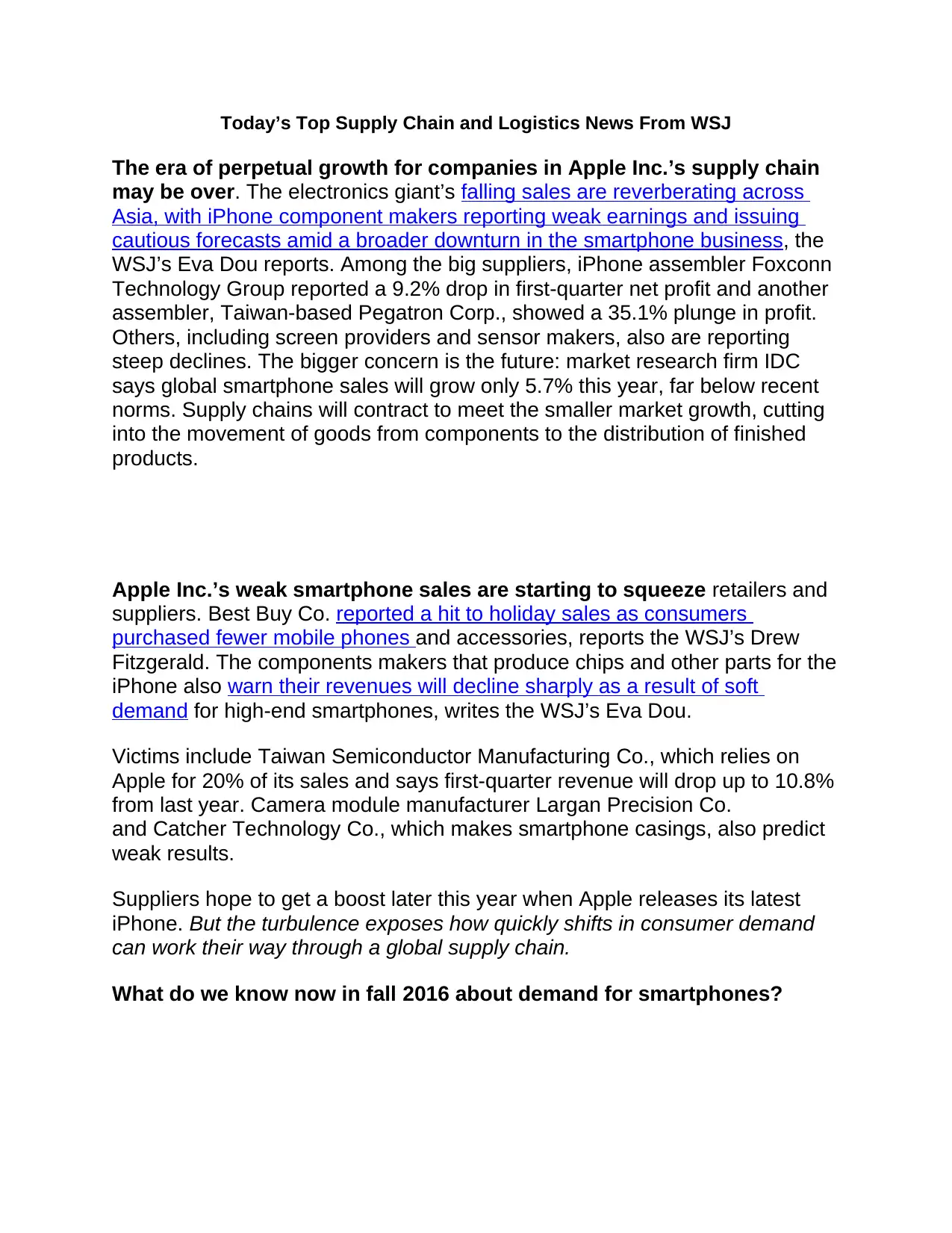
Today’s Top Supply Chain and Logistics News From WSJ
The era of perpetual growth for companies in Apple Inc.’s supply chain
may be over. The electronics giant’s falling sales are reverberating across
Asia, with iPhone component makers reporting weak earnings and issuing
cautious forecasts amid a broader downturn in the smartphone business, the
WSJ’s Eva Dou reports. Among the big suppliers, iPhone assembler Foxconn
Technology Group reported a 9.2% drop in first-quarter net profit and another
assembler, Taiwan-based Pegatron Corp., showed a 35.1% plunge in profit.
Others, including screen providers and sensor makers, also are reporting
steep declines. The bigger concern is the future: market research firm IDC
says global smartphone sales will grow only 5.7% this year, far below recent
norms. Supply chains will contract to meet the smaller market growth, cutting
into the movement of goods from components to the distribution of finished
products.
Apple Inc.’s weak smartphone sales are starting to squeeze retailers and
suppliers. Best Buy Co. reported a hit to holiday sales as consumers
purchased fewer mobile phones and accessories, reports the WSJ’s Drew
Fitzgerald. The components makers that produce chips and other parts for the
iPhone also warn their revenues will decline sharply as a result of soft
demand for high-end smartphones, writes the WSJ’s Eva Dou.
Victims include Taiwan Semiconductor Manufacturing Co., which relies on
Apple for 20% of its sales and says first-quarter revenue will drop up to 10.8%
from last year. Camera module manufacturer Largan Precision Co.
and Catcher Technology Co., which makes smartphone casings, also predict
weak results.
Suppliers hope to get a boost later this year when Apple releases its latest
iPhone. But the turbulence exposes how quickly shifts in consumer demand
can work their way through a global supply chain.
What do we know now in fall 2016 about demand for smartphones?
The era of perpetual growth for companies in Apple Inc.’s supply chain
may be over. The electronics giant’s falling sales are reverberating across
Asia, with iPhone component makers reporting weak earnings and issuing
cautious forecasts amid a broader downturn in the smartphone business, the
WSJ’s Eva Dou reports. Among the big suppliers, iPhone assembler Foxconn
Technology Group reported a 9.2% drop in first-quarter net profit and another
assembler, Taiwan-based Pegatron Corp., showed a 35.1% plunge in profit.
Others, including screen providers and sensor makers, also are reporting
steep declines. The bigger concern is the future: market research firm IDC
says global smartphone sales will grow only 5.7% this year, far below recent
norms. Supply chains will contract to meet the smaller market growth, cutting
into the movement of goods from components to the distribution of finished
products.
Apple Inc.’s weak smartphone sales are starting to squeeze retailers and
suppliers. Best Buy Co. reported a hit to holiday sales as consumers
purchased fewer mobile phones and accessories, reports the WSJ’s Drew
Fitzgerald. The components makers that produce chips and other parts for the
iPhone also warn their revenues will decline sharply as a result of soft
demand for high-end smartphones, writes the WSJ’s Eva Dou.
Victims include Taiwan Semiconductor Manufacturing Co., which relies on
Apple for 20% of its sales and says first-quarter revenue will drop up to 10.8%
from last year. Camera module manufacturer Largan Precision Co.
and Catcher Technology Co., which makes smartphone casings, also predict
weak results.
Suppliers hope to get a boost later this year when Apple releases its latest
iPhone. But the turbulence exposes how quickly shifts in consumer demand
can work their way through a global supply chain.
What do we know now in fall 2016 about demand for smartphones?
Secure Best Marks with AI Grader
Need help grading? Try our AI Grader for instant feedback on your assignments.
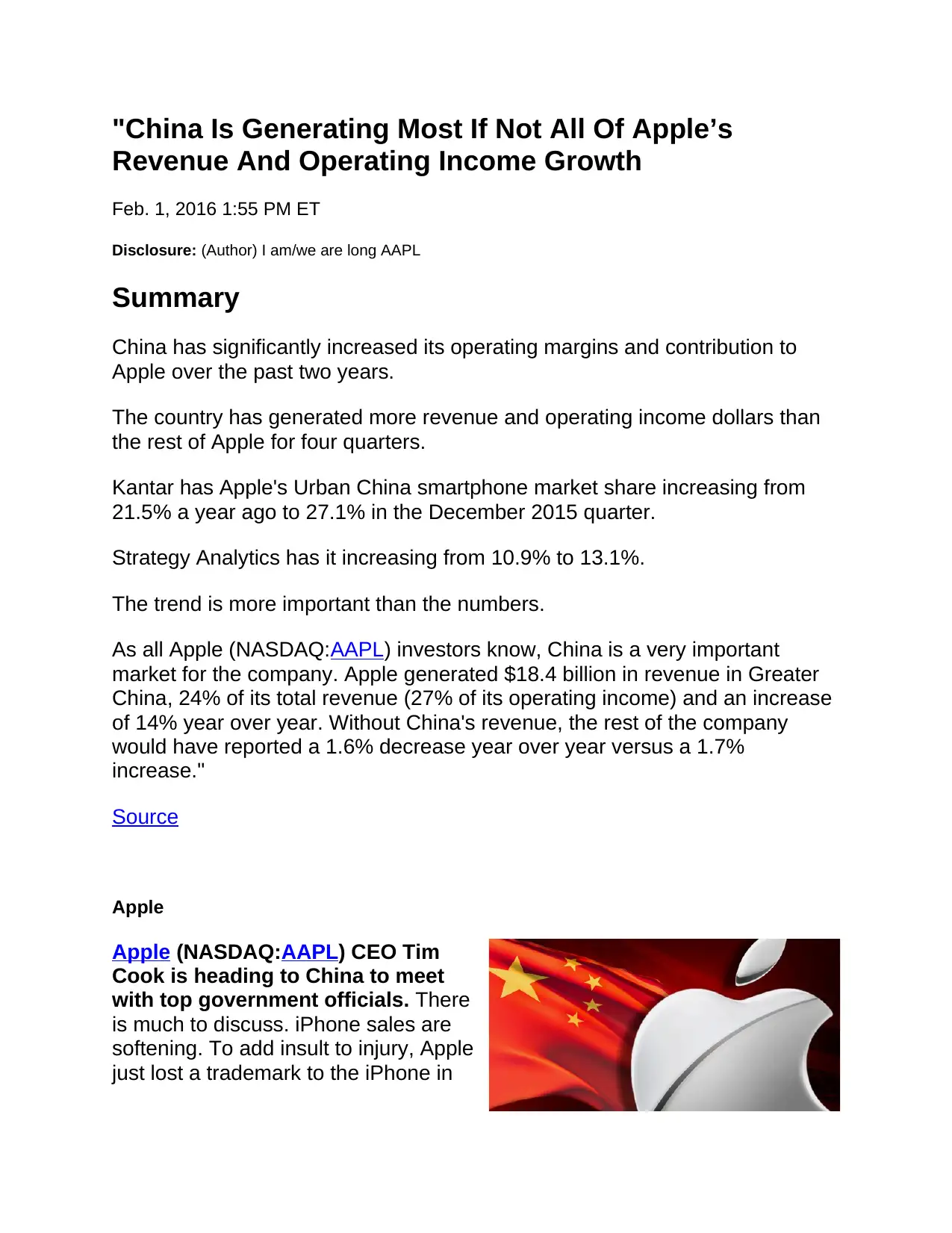
"China Is Generating Most If Not All Of Apple’s
Revenue And Operating Income Growth
Feb. 1, 2016 1:55 PM ET
Disclosure: (Author) I am/we are long AAPL
Summary
China has significantly increased its operating margins and contribution to
Apple over the past two years.
The country has generated more revenue and operating income dollars than
the rest of Apple for four quarters.
Kantar has Apple's Urban China smartphone market share increasing from
21.5% a year ago to 27.1% in the December 2015 quarter.
Strategy Analytics has it increasing from 10.9% to 13.1%.
The trend is more important than the numbers.
As all Apple (NASDAQ:AAPL) investors know, China is a very important
market for the company. Apple generated $18.4 billion in revenue in Greater
China, 24% of its total revenue (27% of its operating income) and an increase
of 14% year over year. Without China's revenue, the rest of the company
would have reported a 1.6% decrease year over year versus a 1.7%
increase."
Source
Apple
Apple (NASDAQ:AAPL) CEO Tim
Cook is heading to China to meet
with top government officials. There
is much to discuss. iPhone sales are
softening. To add insult to injury, Apple
just lost a trademark to the iPhone in
Revenue And Operating Income Growth
Feb. 1, 2016 1:55 PM ET
Disclosure: (Author) I am/we are long AAPL
Summary
China has significantly increased its operating margins and contribution to
Apple over the past two years.
The country has generated more revenue and operating income dollars than
the rest of Apple for four quarters.
Kantar has Apple's Urban China smartphone market share increasing from
21.5% a year ago to 27.1% in the December 2015 quarter.
Strategy Analytics has it increasing from 10.9% to 13.1%.
The trend is more important than the numbers.
As all Apple (NASDAQ:AAPL) investors know, China is a very important
market for the company. Apple generated $18.4 billion in revenue in Greater
China, 24% of its total revenue (27% of its operating income) and an increase
of 14% year over year. Without China's revenue, the rest of the company
would have reported a 1.6% decrease year over year versus a 1.7%
increase."
Source
Apple
Apple (NASDAQ:AAPL) CEO Tim
Cook is heading to China to meet
with top government officials. There
is much to discuss. iPhone sales are
softening. To add insult to injury, Apple
just lost a trademark to the iPhone in
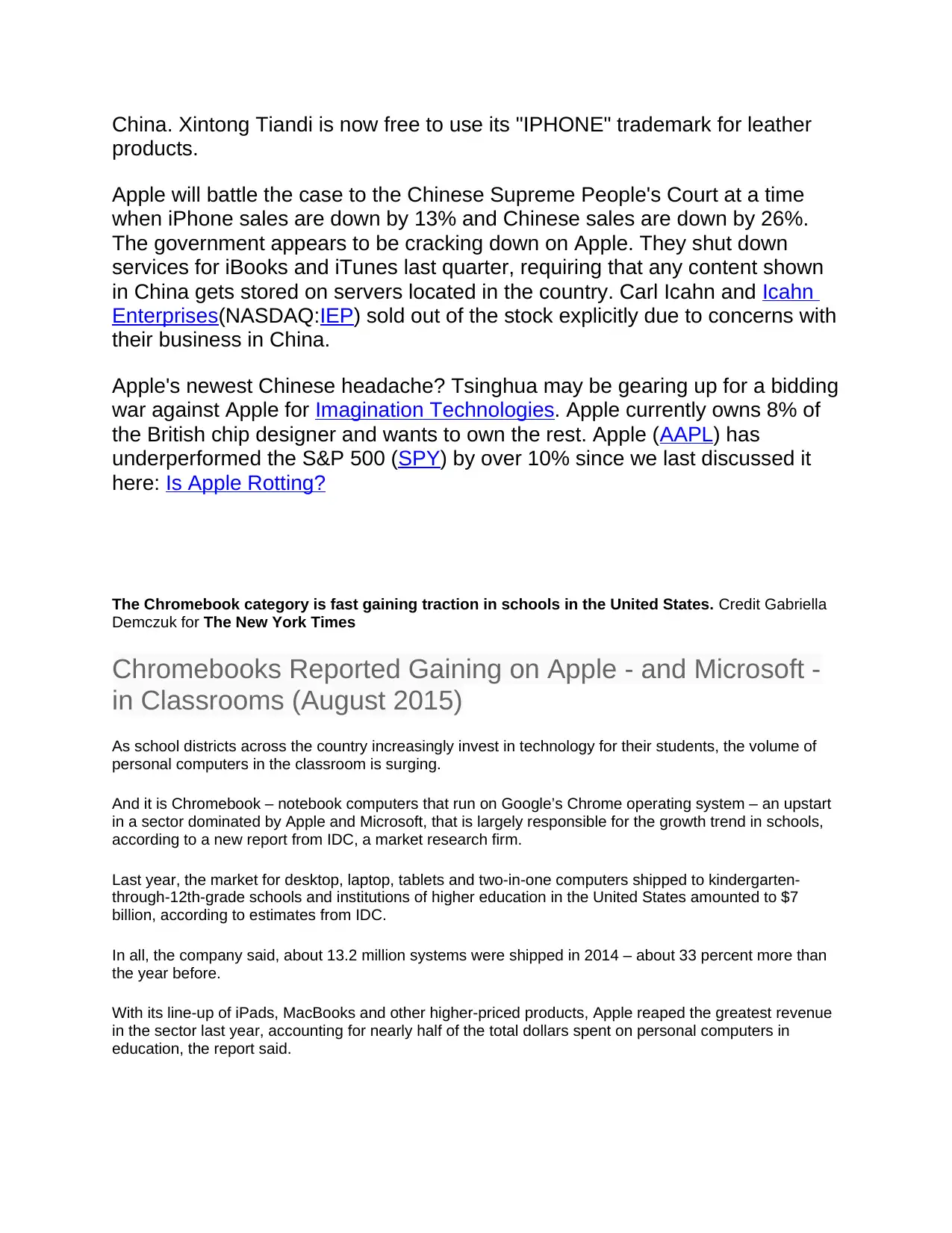
China. Xintong Tiandi is now free to use its "IPHONE" trademark for leather
products.
Apple will battle the case to the Chinese Supreme People's Court at a time
when iPhone sales are down by 13% and Chinese sales are down by 26%.
The government appears to be cracking down on Apple. They shut down
services for iBooks and iTunes last quarter, requiring that any content shown
in China gets stored on servers located in the country. Carl Icahn and Icahn
Enterprises(NASDAQ:IEP) sold out of the stock explicitly due to concerns with
their business in China.
Apple's newest Chinese headache? Tsinghua may be gearing up for a bidding
war against Apple for Imagination Technologies. Apple currently owns 8% of
the British chip designer and wants to own the rest. Apple (AAPL) has
underperformed the S&P 500 (SPY) by over 10% since we last discussed it
here: Is Apple Rotting?
The Chromebook category is fast gaining traction in schools in the United States. Credit Gabriella
Demczuk for The New York Times
Chromebooks Reported Gaining on Apple - and Microsoft -
in Classrooms (August 2015)
As school districts across the country increasingly invest in technology for their students, the volume of
personal computers in the classroom is surging.
And it is Chromebook – notebook computers that run on Google’s Chrome operating system – an upstart
in a sector dominated by Apple and Microsoft, that is largely responsible for the growth trend in schools,
according to a new report from IDC, a market research firm.
Last year, the market for desktop, laptop, tablets and two-in-one computers shipped to kindergarten-
through-12th-grade schools and institutions of higher education in the United States amounted to $7
billion, according to estimates from IDC.
In all, the company said, about 13.2 million systems were shipped in 2014 – about 33 percent more than
the year before.
With its line-up of iPads, MacBooks and other higher-priced products, Apple reaped the greatest revenue
in the sector last year, accounting for nearly half of the total dollars spent on personal computers in
education, the report said.
products.
Apple will battle the case to the Chinese Supreme People's Court at a time
when iPhone sales are down by 13% and Chinese sales are down by 26%.
The government appears to be cracking down on Apple. They shut down
services for iBooks and iTunes last quarter, requiring that any content shown
in China gets stored on servers located in the country. Carl Icahn and Icahn
Enterprises(NASDAQ:IEP) sold out of the stock explicitly due to concerns with
their business in China.
Apple's newest Chinese headache? Tsinghua may be gearing up for a bidding
war against Apple for Imagination Technologies. Apple currently owns 8% of
the British chip designer and wants to own the rest. Apple (AAPL) has
underperformed the S&P 500 (SPY) by over 10% since we last discussed it
here: Is Apple Rotting?
The Chromebook category is fast gaining traction in schools in the United States. Credit Gabriella
Demczuk for The New York Times
Chromebooks Reported Gaining on Apple - and Microsoft -
in Classrooms (August 2015)
As school districts across the country increasingly invest in technology for their students, the volume of
personal computers in the classroom is surging.
And it is Chromebook – notebook computers that run on Google’s Chrome operating system – an upstart
in a sector dominated by Apple and Microsoft, that is largely responsible for the growth trend in schools,
according to a new report from IDC, a market research firm.
Last year, the market for desktop, laptop, tablets and two-in-one computers shipped to kindergarten-
through-12th-grade schools and institutions of higher education in the United States amounted to $7
billion, according to estimates from IDC.
In all, the company said, about 13.2 million systems were shipped in 2014 – about 33 percent more than
the year before.
With its line-up of iPads, MacBooks and other higher-priced products, Apple reaped the greatest revenue
in the sector last year, accounting for nearly half of the total dollars spent on personal computers in
education, the report said.

In terms of the sheer numbers of devices sold, however, Microsoft remained in the lead. In 2014, about
4.9 million Windows devices, including notebooks and desktops, shipped to schools, giving Microsoft a
roughly 38 percent market share in unit sales, IDC said.
Apple, meanwhile, shipped about 4.2 million devices for schools, including desktops, notebook computers
and tablets, accounting for about 32 percent of the education market, according to the report.
But the Chromebook category is fast gaining traction in the United States.
Last year, about 3.9 million Chromebooks were shipped in the education sector, an increase in unit sales
of more than 310 percent compared with the previous year, IDC said. By contrast, iPad unit sales for
education fell last year to 2.7 million devices, compared to 2.9 million in 2013, according to IDC data.
“Even if Microsoft is No. 1 in volume and Apple is No. 1 in revenue, from the growth perspective, nobody
can beat Chromebook,” said Rajani Singh, a senior research analyst at IDC who tracks the personal
computer market and is the author of the report.
Opinion: Apple's Smartphone Future (March 2016)
Summary
For the first time ever Apple sold fewer iPhones y/y in Q414. It also lost
market share to the tune of 3%.
I do not think this is related to Apple's upgrade cycle. The high end
smartphone segment is saturated, and Apple controls almost all of it.
And while I do not think the rumored iPhone SE will do much to solve
this problem, its trade-in program coupled with selling used iPhones to
India will.
According to Gartner, Apple (NASDAQ:AAPL) sold 71.5 million smartphones
in Q415 vs. 74.8 million smartphones in Q414.
4.9 million Windows devices, including notebooks and desktops, shipped to schools, giving Microsoft a
roughly 38 percent market share in unit sales, IDC said.
Apple, meanwhile, shipped about 4.2 million devices for schools, including desktops, notebook computers
and tablets, accounting for about 32 percent of the education market, according to the report.
But the Chromebook category is fast gaining traction in the United States.
Last year, about 3.9 million Chromebooks were shipped in the education sector, an increase in unit sales
of more than 310 percent compared with the previous year, IDC said. By contrast, iPad unit sales for
education fell last year to 2.7 million devices, compared to 2.9 million in 2013, according to IDC data.
“Even if Microsoft is No. 1 in volume and Apple is No. 1 in revenue, from the growth perspective, nobody
can beat Chromebook,” said Rajani Singh, a senior research analyst at IDC who tracks the personal
computer market and is the author of the report.
Opinion: Apple's Smartphone Future (March 2016)
Summary
For the first time ever Apple sold fewer iPhones y/y in Q414. It also lost
market share to the tune of 3%.
I do not think this is related to Apple's upgrade cycle. The high end
smartphone segment is saturated, and Apple controls almost all of it.
And while I do not think the rumored iPhone SE will do much to solve
this problem, its trade-in program coupled with selling used iPhones to
India will.
According to Gartner, Apple (NASDAQ:AAPL) sold 71.5 million smartphones
in Q415 vs. 74.8 million smartphones in Q414.
Paraphrase This Document
Need a fresh take? Get an instant paraphrase of this document with our AI Paraphraser
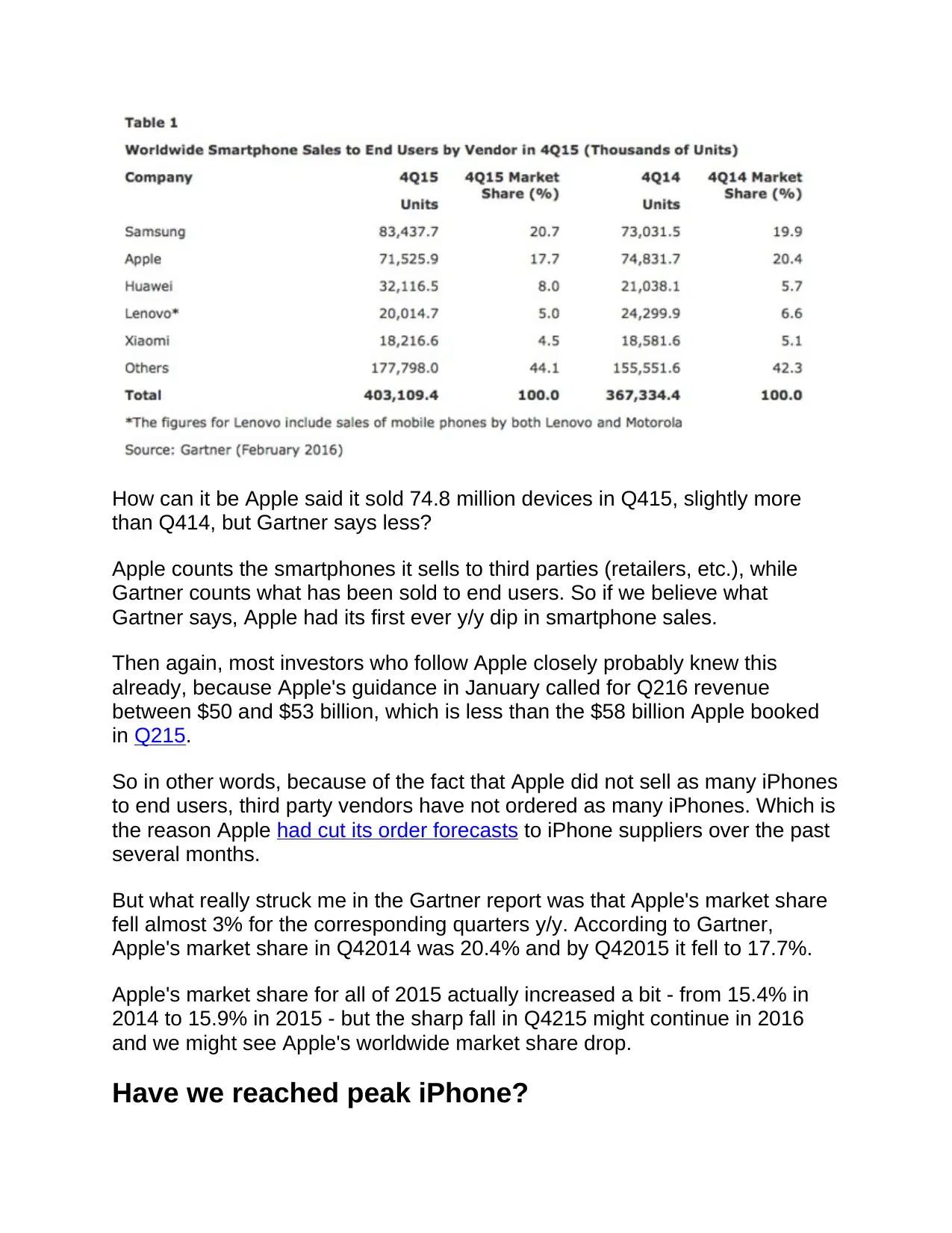
How can it be Apple said it sold 74.8 million devices in Q415, slightly more
than Q414, but Gartner says less?
Apple counts the smartphones it sells to third parties (retailers, etc.), while
Gartner counts what has been sold to end users. So if we believe what
Gartner says, Apple had its first ever y/y dip in smartphone sales.
Then again, most investors who follow Apple closely probably knew this
already, because Apple's guidance in January called for Q216 revenue
between $50 and $53 billion, which is less than the $58 billion Apple booked
in Q215.
So in other words, because of the fact that Apple did not sell as many iPhones
to end users, third party vendors have not ordered as many iPhones. Which is
the reason Apple had cut its order forecasts to iPhone suppliers over the past
several months.
But what really struck me in the Gartner report was that Apple's market share
fell almost 3% for the corresponding quarters y/y. According to Gartner,
Apple's market share in Q42014 was 20.4% and by Q42015 it fell to 17.7%.
Apple's market share for all of 2015 actually increased a bit - from 15.4% in
2014 to 15.9% in 2015 - but the sharp fall in Q4215 might continue in 2016
and we might see Apple's worldwide market share drop.
Have we reached peak iPhone?
than Q414, but Gartner says less?
Apple counts the smartphones it sells to third parties (retailers, etc.), while
Gartner counts what has been sold to end users. So if we believe what
Gartner says, Apple had its first ever y/y dip in smartphone sales.
Then again, most investors who follow Apple closely probably knew this
already, because Apple's guidance in January called for Q216 revenue
between $50 and $53 billion, which is less than the $58 billion Apple booked
in Q215.
So in other words, because of the fact that Apple did not sell as many iPhones
to end users, third party vendors have not ordered as many iPhones. Which is
the reason Apple had cut its order forecasts to iPhone suppliers over the past
several months.
But what really struck me in the Gartner report was that Apple's market share
fell almost 3% for the corresponding quarters y/y. According to Gartner,
Apple's market share in Q42014 was 20.4% and by Q42015 it fell to 17.7%.
Apple's market share for all of 2015 actually increased a bit - from 15.4% in
2014 to 15.9% in 2015 - but the sharp fall in Q4215 might continue in 2016
and we might see Apple's worldwide market share drop.
Have we reached peak iPhone?
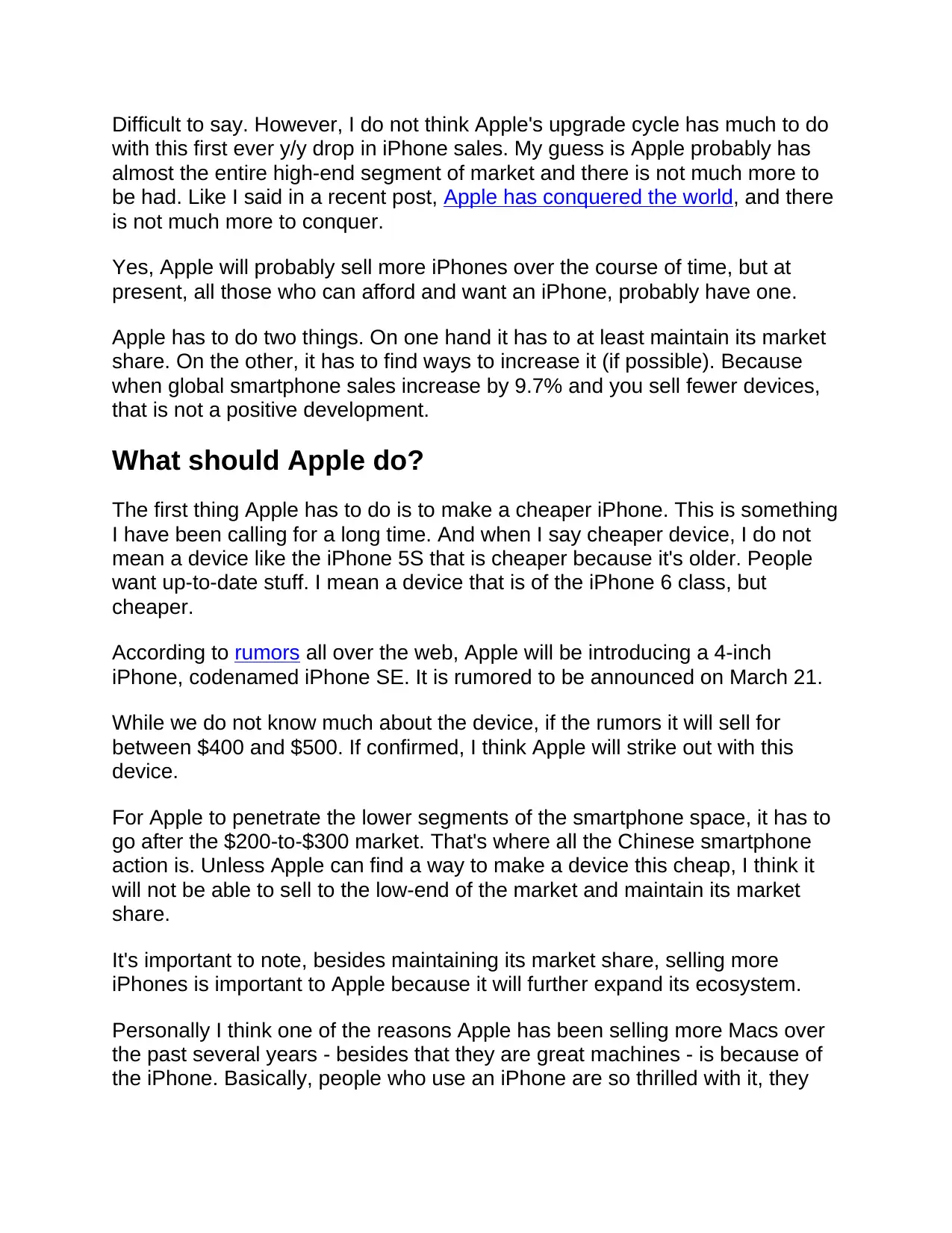
Difficult to say. However, I do not think Apple's upgrade cycle has much to do
with this first ever y/y drop in iPhone sales. My guess is Apple probably has
almost the entire high-end segment of market and there is not much more to
be had. Like I said in a recent post, Apple has conquered the world, and there
is not much more to conquer.
Yes, Apple will probably sell more iPhones over the course of time, but at
present, all those who can afford and want an iPhone, probably have one.
Apple has to do two things. On one hand it has to at least maintain its market
share. On the other, it has to find ways to increase it (if possible). Because
when global smartphone sales increase by 9.7% and you sell fewer devices,
that is not a positive development.
What should Apple do?
The first thing Apple has to do is to make a cheaper iPhone. This is something
I have been calling for a long time. And when I say cheaper device, I do not
mean a device like the iPhone 5S that is cheaper because it's older. People
want up-to-date stuff. I mean a device that is of the iPhone 6 class, but
cheaper.
According to rumors all over the web, Apple will be introducing a 4-inch
iPhone, codenamed iPhone SE. It is rumored to be announced on March 21.
While we do not know much about the device, if the rumors it will sell for
between $400 and $500. If confirmed, I think Apple will strike out with this
device.
For Apple to penetrate the lower segments of the smartphone space, it has to
go after the $200-to-$300 market. That's where all the Chinese smartphone
action is. Unless Apple can find a way to make a device this cheap, I think it
will not be able to sell to the low-end of the market and maintain its market
share.
It's important to note, besides maintaining its market share, selling more
iPhones is important to Apple because it will further expand its ecosystem.
Personally I think one of the reasons Apple has been selling more Macs over
the past several years - besides that they are great machines - is because of
the iPhone. Basically, people who use an iPhone are so thrilled with it, they
with this first ever y/y drop in iPhone sales. My guess is Apple probably has
almost the entire high-end segment of market and there is not much more to
be had. Like I said in a recent post, Apple has conquered the world, and there
is not much more to conquer.
Yes, Apple will probably sell more iPhones over the course of time, but at
present, all those who can afford and want an iPhone, probably have one.
Apple has to do two things. On one hand it has to at least maintain its market
share. On the other, it has to find ways to increase it (if possible). Because
when global smartphone sales increase by 9.7% and you sell fewer devices,
that is not a positive development.
What should Apple do?
The first thing Apple has to do is to make a cheaper iPhone. This is something
I have been calling for a long time. And when I say cheaper device, I do not
mean a device like the iPhone 5S that is cheaper because it's older. People
want up-to-date stuff. I mean a device that is of the iPhone 6 class, but
cheaper.
According to rumors all over the web, Apple will be introducing a 4-inch
iPhone, codenamed iPhone SE. It is rumored to be announced on March 21.
While we do not know much about the device, if the rumors it will sell for
between $400 and $500. If confirmed, I think Apple will strike out with this
device.
For Apple to penetrate the lower segments of the smartphone space, it has to
go after the $200-to-$300 market. That's where all the Chinese smartphone
action is. Unless Apple can find a way to make a device this cheap, I think it
will not be able to sell to the low-end of the market and maintain its market
share.
It's important to note, besides maintaining its market share, selling more
iPhones is important to Apple because it will further expand its ecosystem.
Personally I think one of the reasons Apple has been selling more Macs over
the past several years - besides that they are great machines - is because of
the iPhone. Basically, people who use an iPhone are so thrilled with it, they
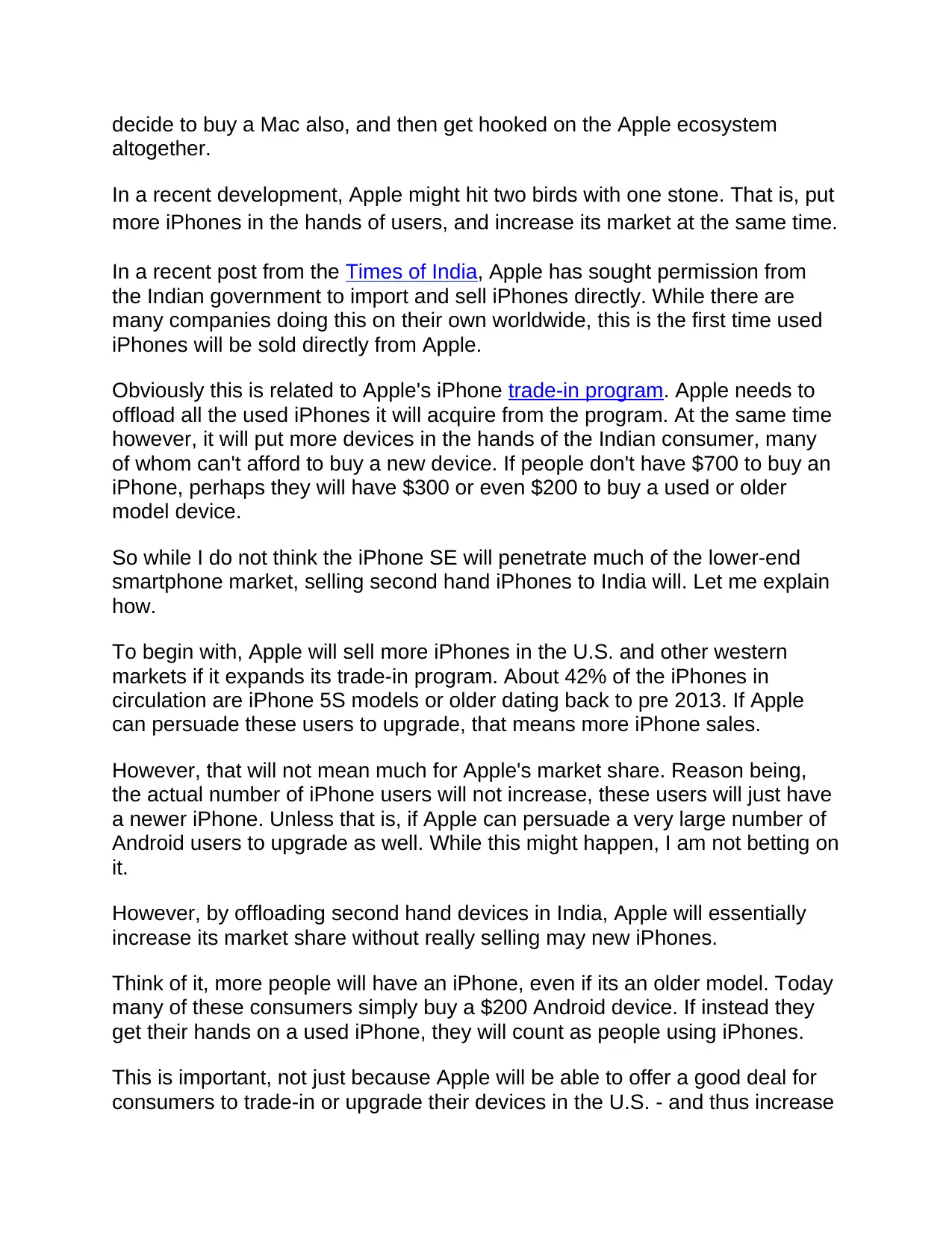
decide to buy a Mac also, and then get hooked on the Apple ecosystem
altogether.
In a recent development, Apple might hit two birds with one stone. That is, put
more iPhones in the hands of users, and increase its market at the same time.
In a recent post from the Times of India, Apple has sought permission from
the Indian government to import and sell iPhones directly. While there are
many companies doing this on their own worldwide, this is the first time used
iPhones will be sold directly from Apple.
Obviously this is related to Apple's iPhone trade-in program. Apple needs to
offload all the used iPhones it will acquire from the program. At the same time
however, it will put more devices in the hands of the Indian consumer, many
of whom can't afford to buy a new device. If people don't have $700 to buy an
iPhone, perhaps they will have $300 or even $200 to buy a used or older
model device.
So while I do not think the iPhone SE will penetrate much of the lower-end
smartphone market, selling second hand iPhones to India will. Let me explain
how.
To begin with, Apple will sell more iPhones in the U.S. and other western
markets if it expands its trade-in program. About 42% of the iPhones in
circulation are iPhone 5S models or older dating back to pre 2013. If Apple
can persuade these users to upgrade, that means more iPhone sales.
However, that will not mean much for Apple's market share. Reason being,
the actual number of iPhone users will not increase, these users will just have
a newer iPhone. Unless that is, if Apple can persuade a very large number of
Android users to upgrade as well. While this might happen, I am not betting on
it.
However, by offloading second hand devices in India, Apple will essentially
increase its market share without really selling may new iPhones.
Think of it, more people will have an iPhone, even if its an older model. Today
many of these consumers simply buy a $200 Android device. If instead they
get their hands on a used iPhone, they will count as people using iPhones.
This is important, not just because Apple will be able to offer a good deal for
consumers to trade-in or upgrade their devices in the U.S. - and thus increase
altogether.
In a recent development, Apple might hit two birds with one stone. That is, put
more iPhones in the hands of users, and increase its market at the same time.
In a recent post from the Times of India, Apple has sought permission from
the Indian government to import and sell iPhones directly. While there are
many companies doing this on their own worldwide, this is the first time used
iPhones will be sold directly from Apple.
Obviously this is related to Apple's iPhone trade-in program. Apple needs to
offload all the used iPhones it will acquire from the program. At the same time
however, it will put more devices in the hands of the Indian consumer, many
of whom can't afford to buy a new device. If people don't have $700 to buy an
iPhone, perhaps they will have $300 or even $200 to buy a used or older
model device.
So while I do not think the iPhone SE will penetrate much of the lower-end
smartphone market, selling second hand iPhones to India will. Let me explain
how.
To begin with, Apple will sell more iPhones in the U.S. and other western
markets if it expands its trade-in program. About 42% of the iPhones in
circulation are iPhone 5S models or older dating back to pre 2013. If Apple
can persuade these users to upgrade, that means more iPhone sales.
However, that will not mean much for Apple's market share. Reason being,
the actual number of iPhone users will not increase, these users will just have
a newer iPhone. Unless that is, if Apple can persuade a very large number of
Android users to upgrade as well. While this might happen, I am not betting on
it.
However, by offloading second hand devices in India, Apple will essentially
increase its market share without really selling may new iPhones.
Think of it, more people will have an iPhone, even if its an older model. Today
many of these consumers simply buy a $200 Android device. If instead they
get their hands on a used iPhone, they will count as people using iPhones.
This is important, not just because Apple will be able to offer a good deal for
consumers to trade-in or upgrade their devices in the U.S. - and thus increase
Secure Best Marks with AI Grader
Need help grading? Try our AI Grader for instant feedback on your assignments.
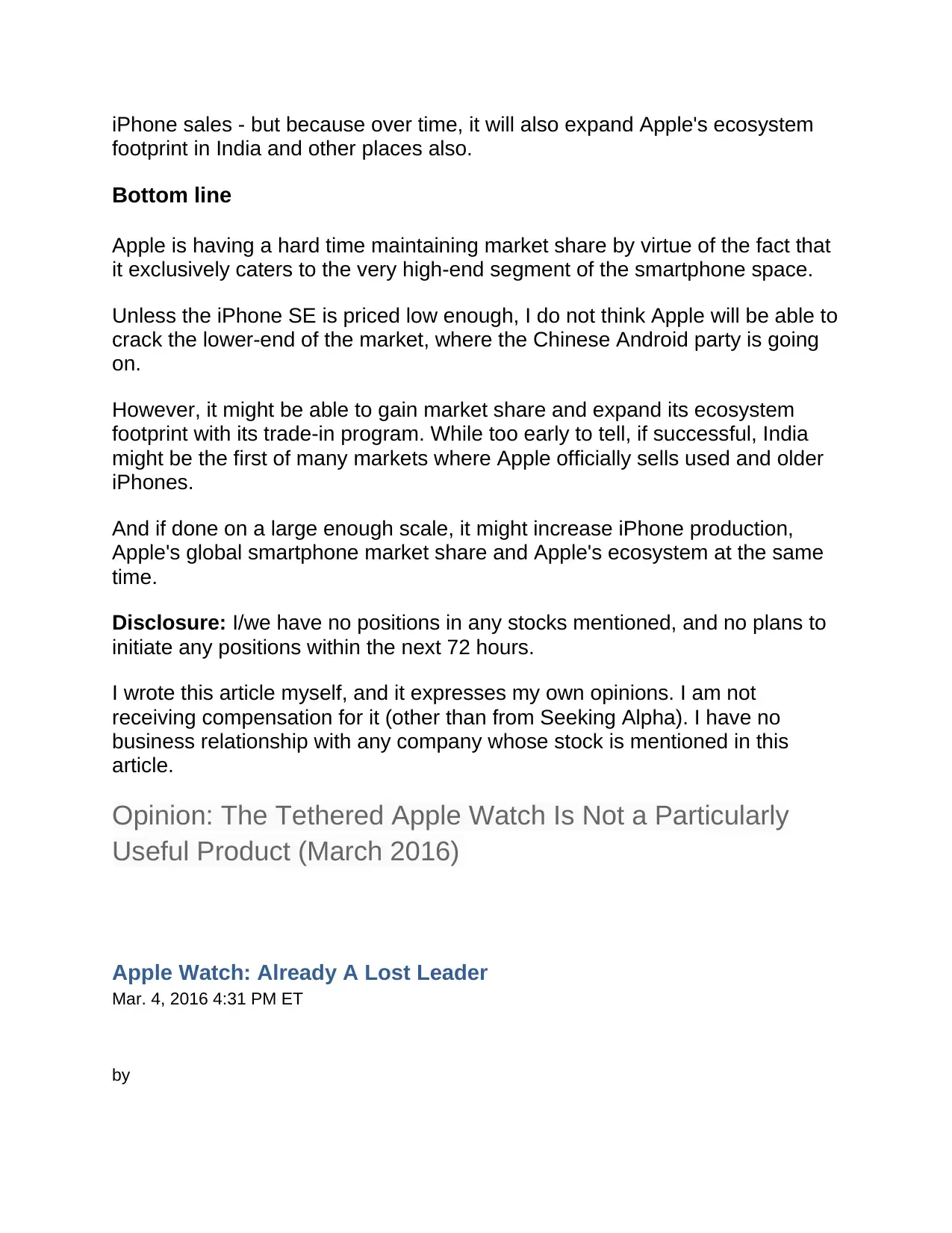
iPhone sales - but because over time, it will also expand Apple's ecosystem
footprint in India and other places also.
Bottom line
Apple is having a hard time maintaining market share by virtue of the fact that
it exclusively caters to the very high-end segment of the smartphone space.
Unless the iPhone SE is priced low enough, I do not think Apple will be able to
crack the lower-end of the market, where the Chinese Android party is going
on.
However, it might be able to gain market share and expand its ecosystem
footprint with its trade-in program. While too early to tell, if successful, India
might be the first of many markets where Apple officially sells used and older
iPhones.
And if done on a large enough scale, it might increase iPhone production,
Apple's global smartphone market share and Apple's ecosystem at the same
time.
Disclosure: I/we have no positions in any stocks mentioned, and no plans to
initiate any positions within the next 72 hours.
I wrote this article myself, and it expresses my own opinions. I am not
receiving compensation for it (other than from Seeking Alpha). I have no
business relationship with any company whose stock is mentioned in this
article.
Opinion: The Tethered Apple Watch Is Not a Particularly
Useful Product (March 2016)
Apple Watch: Already A Lost Leader
Mar. 4, 2016 4:31 PM ET
by
footprint in India and other places also.
Bottom line
Apple is having a hard time maintaining market share by virtue of the fact that
it exclusively caters to the very high-end segment of the smartphone space.
Unless the iPhone SE is priced low enough, I do not think Apple will be able to
crack the lower-end of the market, where the Chinese Android party is going
on.
However, it might be able to gain market share and expand its ecosystem
footprint with its trade-in program. While too early to tell, if successful, India
might be the first of many markets where Apple officially sells used and older
iPhones.
And if done on a large enough scale, it might increase iPhone production,
Apple's global smartphone market share and Apple's ecosystem at the same
time.
Disclosure: I/we have no positions in any stocks mentioned, and no plans to
initiate any positions within the next 72 hours.
I wrote this article myself, and it expresses my own opinions. I am not
receiving compensation for it (other than from Seeking Alpha). I have no
business relationship with any company whose stock is mentioned in this
article.
Opinion: The Tethered Apple Watch Is Not a Particularly
Useful Product (March 2016)
Apple Watch: Already A Lost Leader
Mar. 4, 2016 4:31 PM ET
by
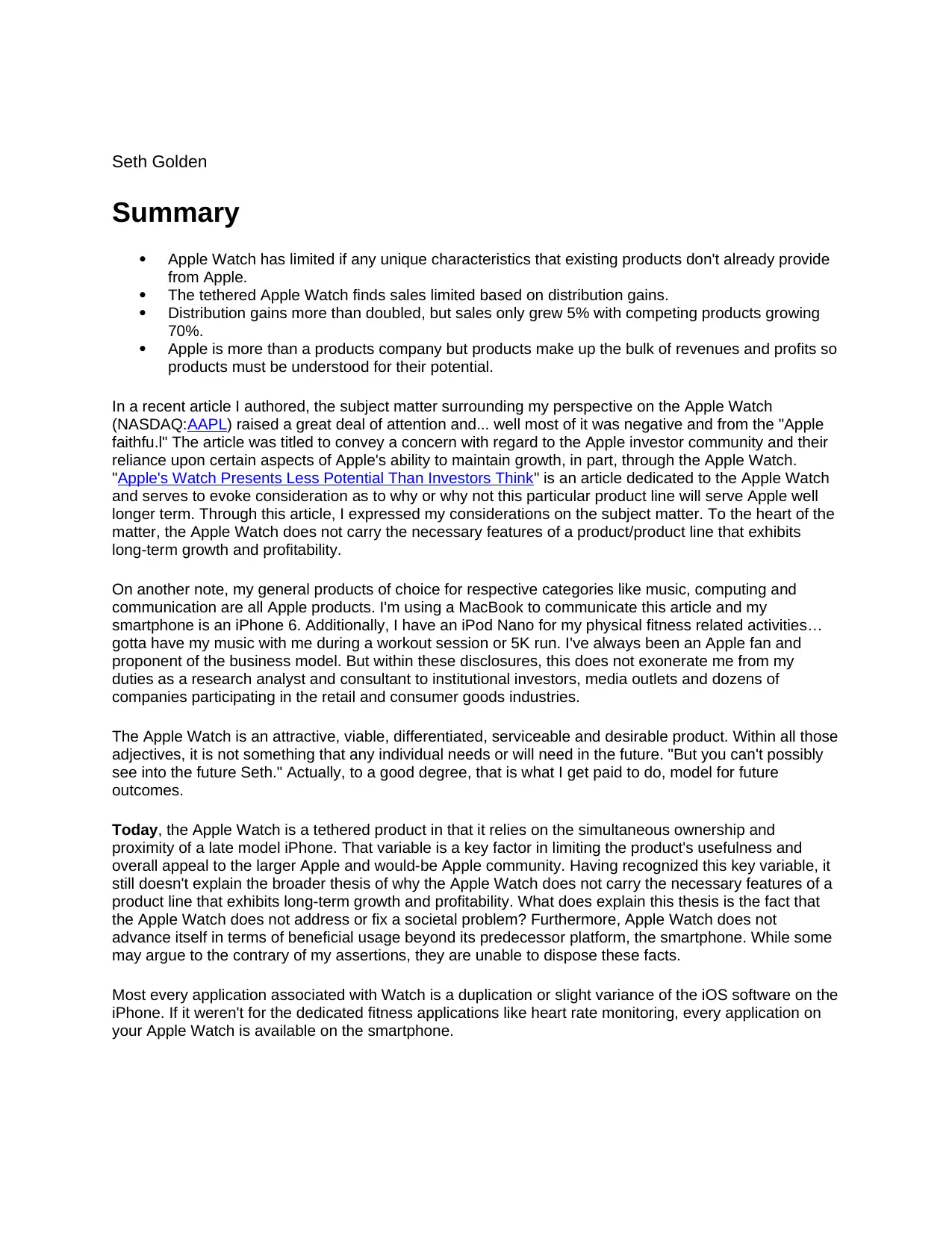
Seth Golden
Summary
Apple Watch has limited if any unique characteristics that existing products don't already provide
from Apple.
The tethered Apple Watch finds sales limited based on distribution gains.
Distribution gains more than doubled, but sales only grew 5% with competing products growing
70%.
Apple is more than a products company but products make up the bulk of revenues and profits so
products must be understood for their potential.
In a recent article I authored, the subject matter surrounding my perspective on the Apple Watch
(NASDAQ:AAPL) raised a great deal of attention and... well most of it was negative and from the "Apple
faithfu.l" The article was titled to convey a concern with regard to the Apple investor community and their
reliance upon certain aspects of Apple's ability to maintain growth, in part, through the Apple Watch.
"Apple's Watch Presents Less Potential Than Investors Think" is an article dedicated to the Apple Watch
and serves to evoke consideration as to why or why not this particular product line will serve Apple well
longer term. Through this article, I expressed my considerations on the subject matter. To the heart of the
matter, the Apple Watch does not carry the necessary features of a product/product line that exhibits
long-term growth and profitability.
On another note, my general products of choice for respective categories like music, computing and
communication are all Apple products. I'm using a MacBook to communicate this article and my
smartphone is an iPhone 6. Additionally, I have an iPod Nano for my physical fitness related activities…
gotta have my music with me during a workout session or 5K run. I've always been an Apple fan and
proponent of the business model. But within these disclosures, this does not exonerate me from my
duties as a research analyst and consultant to institutional investors, media outlets and dozens of
companies participating in the retail and consumer goods industries.
The Apple Watch is an attractive, viable, differentiated, serviceable and desirable product. Within all those
adjectives, it is not something that any individual needs or will need in the future. "But you can't possibly
see into the future Seth." Actually, to a good degree, that is what I get paid to do, model for future
outcomes.
Today, the Apple Watch is a tethered product in that it relies on the simultaneous ownership and
proximity of a late model iPhone. That variable is a key factor in limiting the product's usefulness and
overall appeal to the larger Apple and would-be Apple community. Having recognized this key variable, it
still doesn't explain the broader thesis of why the Apple Watch does not carry the necessary features of a
product line that exhibits long-term growth and profitability. What does explain this thesis is the fact that
the Apple Watch does not address or fix a societal problem? Furthermore, Apple Watch does not
advance itself in terms of beneficial usage beyond its predecessor platform, the smartphone. While some
may argue to the contrary of my assertions, they are unable to dispose these facts.
Most every application associated with Watch is a duplication or slight variance of the iOS software on the
iPhone. If it weren't for the dedicated fitness applications like heart rate monitoring, every application on
your Apple Watch is available on the smartphone.
Summary
Apple Watch has limited if any unique characteristics that existing products don't already provide
from Apple.
The tethered Apple Watch finds sales limited based on distribution gains.
Distribution gains more than doubled, but sales only grew 5% with competing products growing
70%.
Apple is more than a products company but products make up the bulk of revenues and profits so
products must be understood for their potential.
In a recent article I authored, the subject matter surrounding my perspective on the Apple Watch
(NASDAQ:AAPL) raised a great deal of attention and... well most of it was negative and from the "Apple
faithfu.l" The article was titled to convey a concern with regard to the Apple investor community and their
reliance upon certain aspects of Apple's ability to maintain growth, in part, through the Apple Watch.
"Apple's Watch Presents Less Potential Than Investors Think" is an article dedicated to the Apple Watch
and serves to evoke consideration as to why or why not this particular product line will serve Apple well
longer term. Through this article, I expressed my considerations on the subject matter. To the heart of the
matter, the Apple Watch does not carry the necessary features of a product/product line that exhibits
long-term growth and profitability.
On another note, my general products of choice for respective categories like music, computing and
communication are all Apple products. I'm using a MacBook to communicate this article and my
smartphone is an iPhone 6. Additionally, I have an iPod Nano for my physical fitness related activities…
gotta have my music with me during a workout session or 5K run. I've always been an Apple fan and
proponent of the business model. But within these disclosures, this does not exonerate me from my
duties as a research analyst and consultant to institutional investors, media outlets and dozens of
companies participating in the retail and consumer goods industries.
The Apple Watch is an attractive, viable, differentiated, serviceable and desirable product. Within all those
adjectives, it is not something that any individual needs or will need in the future. "But you can't possibly
see into the future Seth." Actually, to a good degree, that is what I get paid to do, model for future
outcomes.
Today, the Apple Watch is a tethered product in that it relies on the simultaneous ownership and
proximity of a late model iPhone. That variable is a key factor in limiting the product's usefulness and
overall appeal to the larger Apple and would-be Apple community. Having recognized this key variable, it
still doesn't explain the broader thesis of why the Apple Watch does not carry the necessary features of a
product line that exhibits long-term growth and profitability. What does explain this thesis is the fact that
the Apple Watch does not address or fix a societal problem? Furthermore, Apple Watch does not
advance itself in terms of beneficial usage beyond its predecessor platform, the smartphone. While some
may argue to the contrary of my assertions, they are unable to dispose these facts.
Most every application associated with Watch is a duplication or slight variance of the iOS software on the
iPhone. If it weren't for the dedicated fitness applications like heart rate monitoring, every application on
your Apple Watch is available on the smartphone.
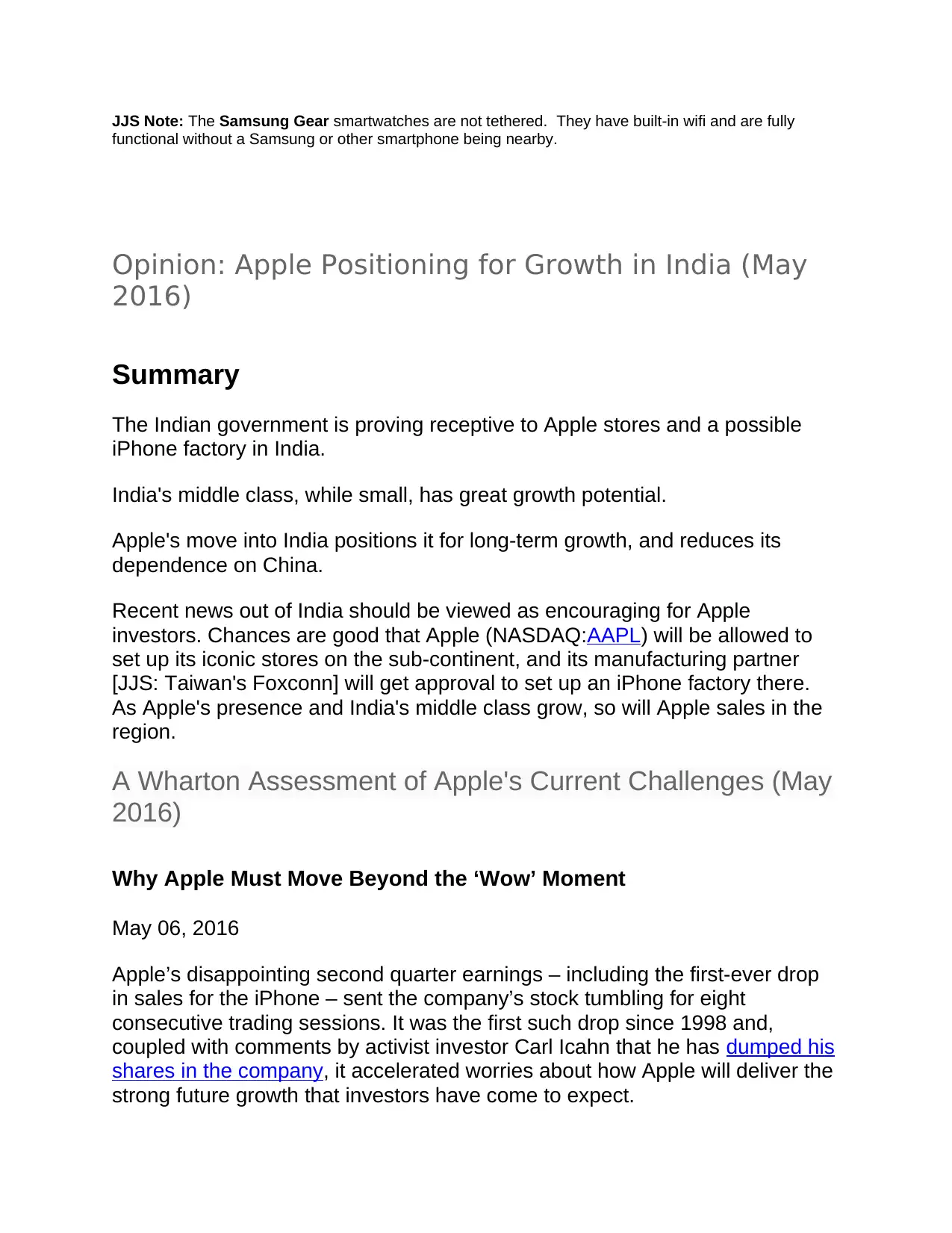
JJS Note: The Samsung Gear smartwatches are not tethered. They have built-in wifi and are fully
functional without a Samsung or other smartphone being nearby.
Opinion: Apple Positioning for Growth in India (May
2016)
Summary
The Indian government is proving receptive to Apple stores and a possible
iPhone factory in India.
India's middle class, while small, has great growth potential.
Apple's move into India positions it for long-term growth, and reduces its
dependence on China.
Recent news out of India should be viewed as encouraging for Apple
investors. Chances are good that Apple (NASDAQ:AAPL) will be allowed to
set up its iconic stores on the sub-continent, and its manufacturing partner
[JJS: Taiwan's Foxconn] will get approval to set up an iPhone factory there.
As Apple's presence and India's middle class grow, so will Apple sales in the
region.
A Wharton Assessment of Apple's Current Challenges (May
2016)
Why Apple Must Move Beyond the ‘Wow’ Moment
May 06, 2016
Apple’s disappointing second quarter earnings – including the first-ever drop
in sales for the iPhone – sent the company’s stock tumbling for eight
consecutive trading sessions. It was the first such drop since 1998 and,
coupled with comments by activist investor Carl Icahn that he has dumped his
shares in the company, it accelerated worries about how Apple will deliver the
strong future growth that investors have come to expect.
functional without a Samsung or other smartphone being nearby.
Opinion: Apple Positioning for Growth in India (May
2016)
Summary
The Indian government is proving receptive to Apple stores and a possible
iPhone factory in India.
India's middle class, while small, has great growth potential.
Apple's move into India positions it for long-term growth, and reduces its
dependence on China.
Recent news out of India should be viewed as encouraging for Apple
investors. Chances are good that Apple (NASDAQ:AAPL) will be allowed to
set up its iconic stores on the sub-continent, and its manufacturing partner
[JJS: Taiwan's Foxconn] will get approval to set up an iPhone factory there.
As Apple's presence and India's middle class grow, so will Apple sales in the
region.
A Wharton Assessment of Apple's Current Challenges (May
2016)
Why Apple Must Move Beyond the ‘Wow’ Moment
May 06, 2016
Apple’s disappointing second quarter earnings – including the first-ever drop
in sales for the iPhone – sent the company’s stock tumbling for eight
consecutive trading sessions. It was the first such drop since 1998 and,
coupled with comments by activist investor Carl Icahn that he has dumped his
shares in the company, it accelerated worries about how Apple will deliver the
strong future growth that investors have come to expect.
Paraphrase This Document
Need a fresh take? Get an instant paraphrase of this document with our AI Paraphraser

Coming off more than a decade of blockbuster products, Apple – the most
valuable company in the world based on market capitalization — has become
so large that Wharton experts say it is now confronting the law of large
numbers, which suggests that its high earnings and growth in share price will
eventually slow.
At this point, what Apple needs is its next iPhone – but Wharton experts
caution that it will take more than moonshots to cement robust future growth
for the company. Moreover, it’s unlikely that the company can come up with a
new hit product that will rapidly improve sales immediately. In the meantime,
the iPhone is coming off a strong upgrade cycle, the iPad has lost momentum,
and the Apple Watch, while successful to some degree, hasn’t moved the
needle as significantly as many past new products.
An Expectations Problem? “No … company can grow forever. Apple has
had an extraordinary run, and it’s still a phenomenally successful company,”
says Kevin Werbach, a legal studies and business ethics professor at
Wharton. “Few companies in history have ever had a product as successful as
the iPhone, so it’s a bit much to expect that Apple find a second one.”
Apple’s sales for the fiscal year ending Sept 30, 2015, were $233.7 billion, up
from $182.8 billion in fiscal 2014. By contrast, in fiscal 2011, Apple sales were
$108.2 billion, which was up from $36.54 billion in fiscal 2009. Wall Street is
expecting Apple to grow revenue by under 4% in fiscal 2016, compared with a
28% revenue expansion in the last fiscal year, Thomson Reuters reported in
January.
While the smartphone market globally may be hitting the saturation point,
Apple CEO Tim Cook noted that the iPhone, which accounts for 65% of the
company’s revenue, can still take share from Android users and grow globally.
Though the earnings announcement was disappointing in the face of past
successes, Apple is hardly hurting: Second quarter net income was $10.5
billion on revenue of $50.6 billion. A year ago, Apple reported second quarter
earnings of $13.6 billion on revenue of $58 billion.
Opinion: On the "Battle" between Tablets and Laptops
(March 2016)
valuable company in the world based on market capitalization — has become
so large that Wharton experts say it is now confronting the law of large
numbers, which suggests that its high earnings and growth in share price will
eventually slow.
At this point, what Apple needs is its next iPhone – but Wharton experts
caution that it will take more than moonshots to cement robust future growth
for the company. Moreover, it’s unlikely that the company can come up with a
new hit product that will rapidly improve sales immediately. In the meantime,
the iPhone is coming off a strong upgrade cycle, the iPad has lost momentum,
and the Apple Watch, while successful to some degree, hasn’t moved the
needle as significantly as many past new products.
An Expectations Problem? “No … company can grow forever. Apple has
had an extraordinary run, and it’s still a phenomenally successful company,”
says Kevin Werbach, a legal studies and business ethics professor at
Wharton. “Few companies in history have ever had a product as successful as
the iPhone, so it’s a bit much to expect that Apple find a second one.”
Apple’s sales for the fiscal year ending Sept 30, 2015, were $233.7 billion, up
from $182.8 billion in fiscal 2014. By contrast, in fiscal 2011, Apple sales were
$108.2 billion, which was up from $36.54 billion in fiscal 2009. Wall Street is
expecting Apple to grow revenue by under 4% in fiscal 2016, compared with a
28% revenue expansion in the last fiscal year, Thomson Reuters reported in
January.
While the smartphone market globally may be hitting the saturation point,
Apple CEO Tim Cook noted that the iPhone, which accounts for 65% of the
company’s revenue, can still take share from Android users and grow globally.
Though the earnings announcement was disappointing in the face of past
successes, Apple is hardly hurting: Second quarter net income was $10.5
billion on revenue of $50.6 billion. A year ago, Apple reported second quarter
earnings of $13.6 billion on revenue of $58 billion.
Opinion: On the "Battle" between Tablets and Laptops
(March 2016)
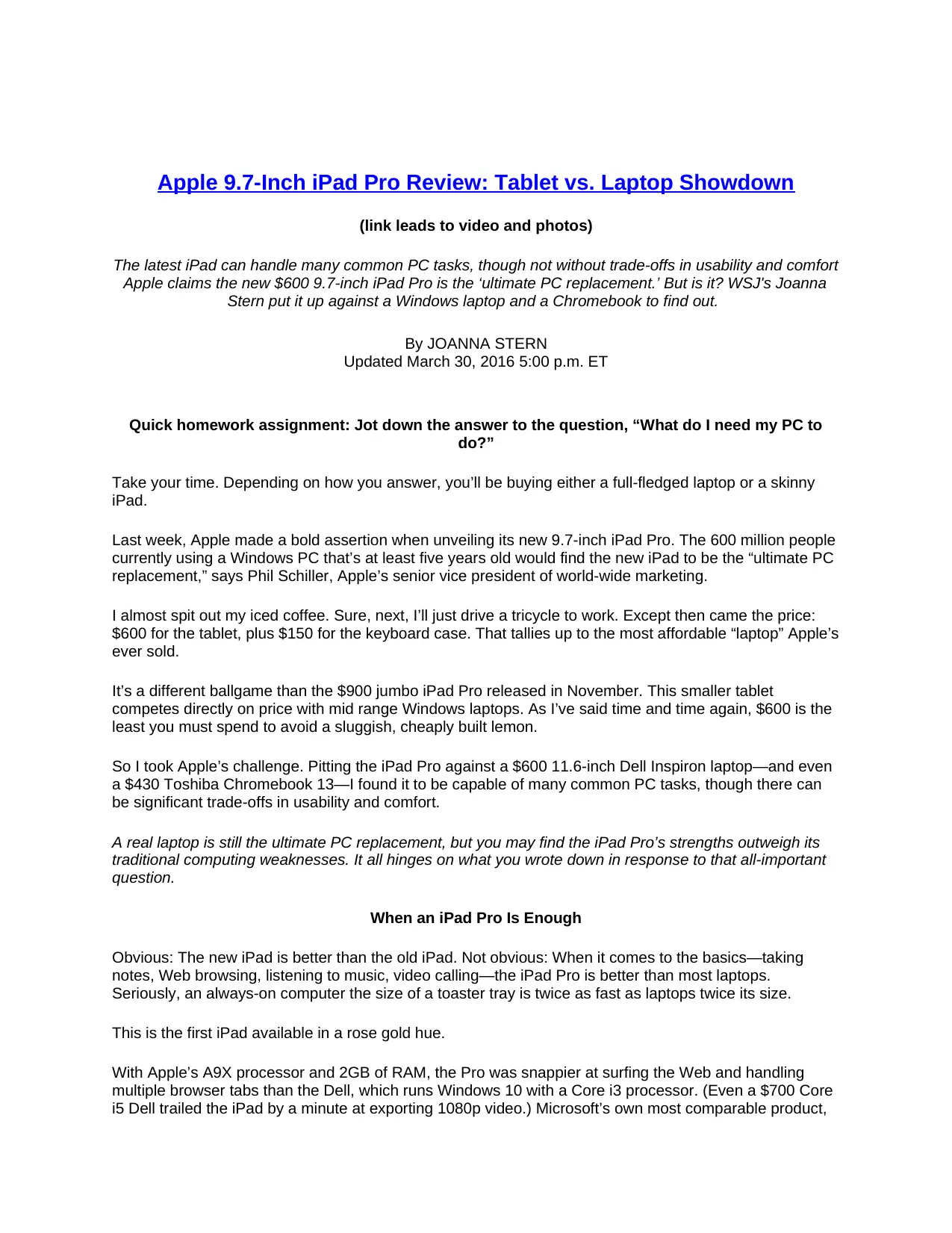
Apple 9.7-Inch iPad Pro Review: Tablet vs. Laptop Showdown
(link leads to video and photos)
The latest iPad can handle many common PC tasks, though not without trade-offs in usability and comfort
Apple claims the new $600 9.7-inch iPad Pro is the ‘ultimate PC replacement.’ But is it? WSJ's Joanna
Stern put it up against a Windows laptop and a Chromebook to find out.
By JOANNA STERN
Updated March 30, 2016 5:00 p.m. ET
Quick homework assignment: Jot down the answer to the question, “What do I need my PC to
do?”
Take your time. Depending on how you answer, you’ll be buying either a full-fledged laptop or a skinny
iPad.
Last week, Apple made a bold assertion when unveiling its new 9.7-inch iPad Pro. The 600 million people
currently using a Windows PC that’s at least five years old would find the new iPad to be the “ultimate PC
replacement,” says Phil Schiller, Apple’s senior vice president of world-wide marketing.
I almost spit out my iced coffee. Sure, next, I’ll just drive a tricycle to work. Except then came the price:
$600 for the tablet, plus $150 for the keyboard case. That tallies up to the most affordable “laptop” Apple’s
ever sold.
It’s a different ballgame than the $900 jumbo iPad Pro released in November. This smaller tablet
competes directly on price with mid range Windows laptops. As I’ve said time and time again, $600 is the
least you must spend to avoid a sluggish, cheaply built lemon.
So I took Apple’s challenge. Pitting the iPad Pro against a $600 11.6-inch Dell Inspiron laptop—and even
a $430 Toshiba Chromebook 13—I found it to be capable of many common PC tasks, though there can
be significant trade-offs in usability and comfort.
A real laptop is still the ultimate PC replacement, but you may find the iPad Pro’s strengths outweigh its
traditional computing weaknesses. It all hinges on what you wrote down in response to that all-important
question.
When an iPad Pro Is Enough
Obvious: The new iPad is better than the old iPad. Not obvious: When it comes to the basics—taking
notes, Web browsing, listening to music, video calling—the iPad Pro is better than most laptops.
Seriously, an always-on computer the size of a toaster tray is twice as fast as laptops twice its size.
This is the first iPad available in a rose gold hue.
With Apple’s A9X processor and 2GB of RAM, the Pro was snappier at surfing the Web and handling
multiple browser tabs than the Dell, which runs Windows 10 with a Core i3 processor. (Even a $700 Core
i5 Dell trailed the iPad by a minute at exporting 1080p video.) Microsoft’s own most comparable product,
(link leads to video and photos)
The latest iPad can handle many common PC tasks, though not without trade-offs in usability and comfort
Apple claims the new $600 9.7-inch iPad Pro is the ‘ultimate PC replacement.’ But is it? WSJ's Joanna
Stern put it up against a Windows laptop and a Chromebook to find out.
By JOANNA STERN
Updated March 30, 2016 5:00 p.m. ET
Quick homework assignment: Jot down the answer to the question, “What do I need my PC to
do?”
Take your time. Depending on how you answer, you’ll be buying either a full-fledged laptop or a skinny
iPad.
Last week, Apple made a bold assertion when unveiling its new 9.7-inch iPad Pro. The 600 million people
currently using a Windows PC that’s at least five years old would find the new iPad to be the “ultimate PC
replacement,” says Phil Schiller, Apple’s senior vice president of world-wide marketing.
I almost spit out my iced coffee. Sure, next, I’ll just drive a tricycle to work. Except then came the price:
$600 for the tablet, plus $150 for the keyboard case. That tallies up to the most affordable “laptop” Apple’s
ever sold.
It’s a different ballgame than the $900 jumbo iPad Pro released in November. This smaller tablet
competes directly on price with mid range Windows laptops. As I’ve said time and time again, $600 is the
least you must spend to avoid a sluggish, cheaply built lemon.
So I took Apple’s challenge. Pitting the iPad Pro against a $600 11.6-inch Dell Inspiron laptop—and even
a $430 Toshiba Chromebook 13—I found it to be capable of many common PC tasks, though there can
be significant trade-offs in usability and comfort.
A real laptop is still the ultimate PC replacement, but you may find the iPad Pro’s strengths outweigh its
traditional computing weaknesses. It all hinges on what you wrote down in response to that all-important
question.
When an iPad Pro Is Enough
Obvious: The new iPad is better than the old iPad. Not obvious: When it comes to the basics—taking
notes, Web browsing, listening to music, video calling—the iPad Pro is better than most laptops.
Seriously, an always-on computer the size of a toaster tray is twice as fast as laptops twice its size.
This is the first iPad available in a rose gold hue.
With Apple’s A9X processor and 2GB of RAM, the Pro was snappier at surfing the Web and handling
multiple browser tabs than the Dell, which runs Windows 10 with a Core i3 processor. (Even a $700 Core
i5 Dell trailed the iPad by a minute at exporting 1080p video.) Microsoft’s own most comparable product,
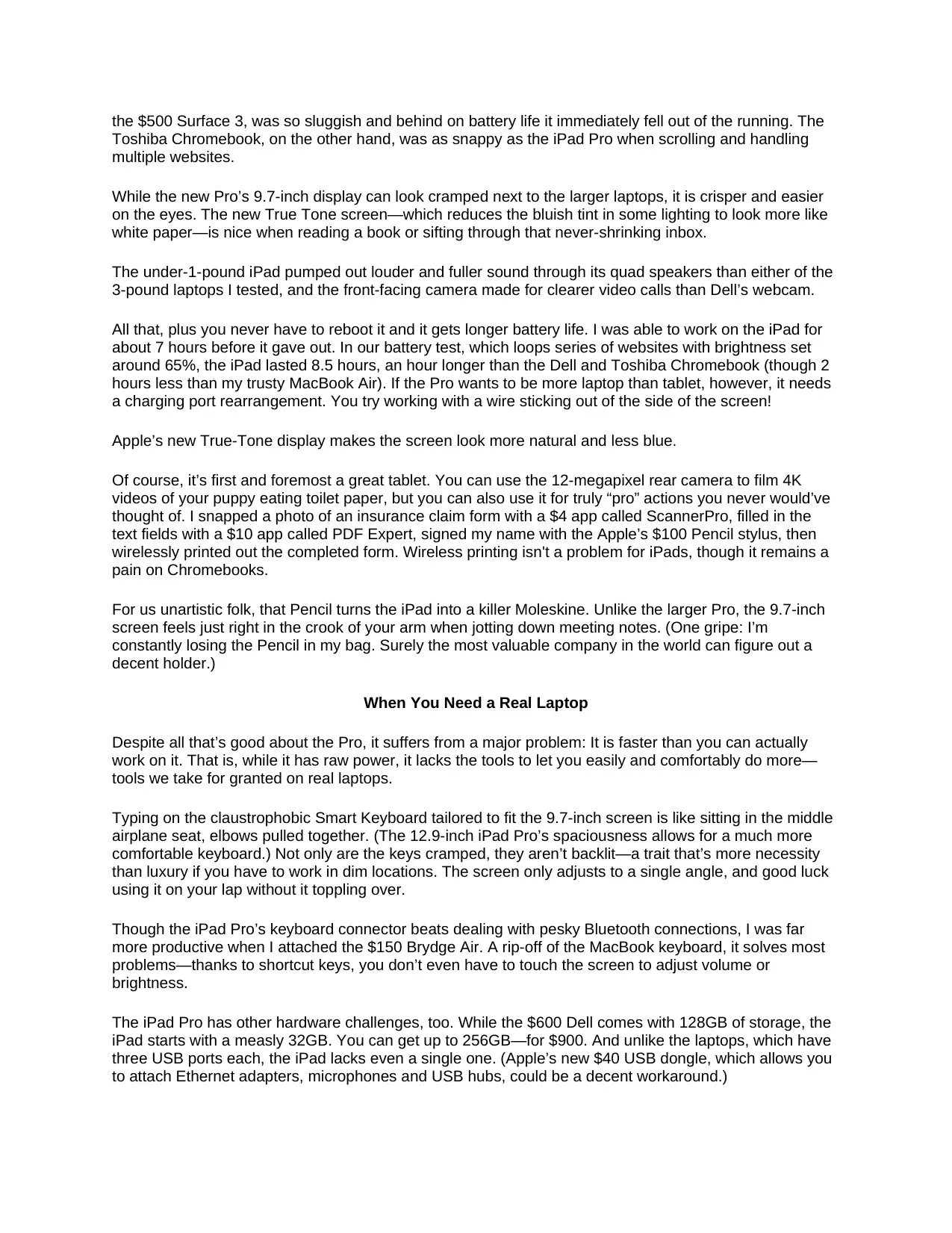
the $500 Surface 3, was so sluggish and behind on battery life it immediately fell out of the running. The
Toshiba Chromebook, on the other hand, was as snappy as the iPad Pro when scrolling and handling
multiple websites.
While the new Pro’s 9.7-inch display can look cramped next to the larger laptops, it is crisper and easier
on the eyes. The new True Tone screen—which reduces the bluish tint in some lighting to look more like
white paper—is nice when reading a book or sifting through that never-shrinking inbox.
The under-1-pound iPad pumped out louder and fuller sound through its quad speakers than either of the
3-pound laptops I tested, and the front-facing camera made for clearer video calls than Dell’s webcam.
All that, plus you never have to reboot it and it gets longer battery life. I was able to work on the iPad for
about 7 hours before it gave out. In our battery test, which loops series of websites with brightness set
around 65%, the iPad lasted 8.5 hours, an hour longer than the Dell and Toshiba Chromebook (though 2
hours less than my trusty MacBook Air). If the Pro wants to be more laptop than tablet, however, it needs
a charging port rearrangement. You try working with a wire sticking out of the side of the screen!
Apple’s new True-Tone display makes the screen look more natural and less blue.
Of course, it’s first and foremost a great tablet. You can use the 12-megapixel rear camera to film 4K
videos of your puppy eating toilet paper, but you can also use it for truly “pro” actions you never would’ve
thought of. I snapped a photo of an insurance claim form with a $4 app called ScannerPro, filled in the
text fields with a $10 app called PDF Expert, signed my name with the Apple’s $100 Pencil stylus, then
wirelessly printed out the completed form. Wireless printing isn't a problem for iPads, though it remains a
pain on Chromebooks.
For us unartistic folk, that Pencil turns the iPad into a killer Moleskine. Unlike the larger Pro, the 9.7-inch
screen feels just right in the crook of your arm when jotting down meeting notes. (One gripe: I’m
constantly losing the Pencil in my bag. Surely the most valuable company in the world can figure out a
decent holder.)
When You Need a Real Laptop
Despite all that’s good about the Pro, it suffers from a major problem: It is faster than you can actually
work on it. That is, while it has raw power, it lacks the tools to let you easily and comfortably do more—
tools we take for granted on real laptops.
Typing on the claustrophobic Smart Keyboard tailored to fit the 9.7-inch screen is like sitting in the middle
airplane seat, elbows pulled together. (The 12.9-inch iPad Pro’s spaciousness allows for a much more
comfortable keyboard.) Not only are the keys cramped, they aren’t backlit—a trait that’s more necessity
than luxury if you have to work in dim locations. The screen only adjusts to a single angle, and good luck
using it on your lap without it toppling over.
Though the iPad Pro’s keyboard connector beats dealing with pesky Bluetooth connections, I was far
more productive when I attached the $150 Brydge Air. A rip-off of the MacBook keyboard, it solves most
problems—thanks to shortcut keys, you don’t even have to touch the screen to adjust volume or
brightness.
The iPad Pro has other hardware challenges, too. While the $600 Dell comes with 128GB of storage, the
iPad starts with a measly 32GB. You can get up to 256GB—for $900. And unlike the laptops, which have
three USB ports each, the iPad lacks even a single one. (Apple’s new $40 USB dongle, which allows you
to attach Ethernet adapters, microphones and USB hubs, could be a decent workaround.)
Toshiba Chromebook, on the other hand, was as snappy as the iPad Pro when scrolling and handling
multiple websites.
While the new Pro’s 9.7-inch display can look cramped next to the larger laptops, it is crisper and easier
on the eyes. The new True Tone screen—which reduces the bluish tint in some lighting to look more like
white paper—is nice when reading a book or sifting through that never-shrinking inbox.
The under-1-pound iPad pumped out louder and fuller sound through its quad speakers than either of the
3-pound laptops I tested, and the front-facing camera made for clearer video calls than Dell’s webcam.
All that, plus you never have to reboot it and it gets longer battery life. I was able to work on the iPad for
about 7 hours before it gave out. In our battery test, which loops series of websites with brightness set
around 65%, the iPad lasted 8.5 hours, an hour longer than the Dell and Toshiba Chromebook (though 2
hours less than my trusty MacBook Air). If the Pro wants to be more laptop than tablet, however, it needs
a charging port rearrangement. You try working with a wire sticking out of the side of the screen!
Apple’s new True-Tone display makes the screen look more natural and less blue.
Of course, it’s first and foremost a great tablet. You can use the 12-megapixel rear camera to film 4K
videos of your puppy eating toilet paper, but you can also use it for truly “pro” actions you never would’ve
thought of. I snapped a photo of an insurance claim form with a $4 app called ScannerPro, filled in the
text fields with a $10 app called PDF Expert, signed my name with the Apple’s $100 Pencil stylus, then
wirelessly printed out the completed form. Wireless printing isn't a problem for iPads, though it remains a
pain on Chromebooks.
For us unartistic folk, that Pencil turns the iPad into a killer Moleskine. Unlike the larger Pro, the 9.7-inch
screen feels just right in the crook of your arm when jotting down meeting notes. (One gripe: I’m
constantly losing the Pencil in my bag. Surely the most valuable company in the world can figure out a
decent holder.)
When You Need a Real Laptop
Despite all that’s good about the Pro, it suffers from a major problem: It is faster than you can actually
work on it. That is, while it has raw power, it lacks the tools to let you easily and comfortably do more—
tools we take for granted on real laptops.
Typing on the claustrophobic Smart Keyboard tailored to fit the 9.7-inch screen is like sitting in the middle
airplane seat, elbows pulled together. (The 12.9-inch iPad Pro’s spaciousness allows for a much more
comfortable keyboard.) Not only are the keys cramped, they aren’t backlit—a trait that’s more necessity
than luxury if you have to work in dim locations. The screen only adjusts to a single angle, and good luck
using it on your lap without it toppling over.
Though the iPad Pro’s keyboard connector beats dealing with pesky Bluetooth connections, I was far
more productive when I attached the $150 Brydge Air. A rip-off of the MacBook keyboard, it solves most
problems—thanks to shortcut keys, you don’t even have to touch the screen to adjust volume or
brightness.
The iPad Pro has other hardware challenges, too. While the $600 Dell comes with 128GB of storage, the
iPad starts with a measly 32GB. You can get up to 256GB—for $900. And unlike the laptops, which have
three USB ports each, the iPad lacks even a single one. (Apple’s new $40 USB dongle, which allows you
to attach Ethernet adapters, microphones and USB hubs, could be a decent workaround.)
Secure Best Marks with AI Grader
Need help grading? Try our AI Grader for instant feedback on your assignments.
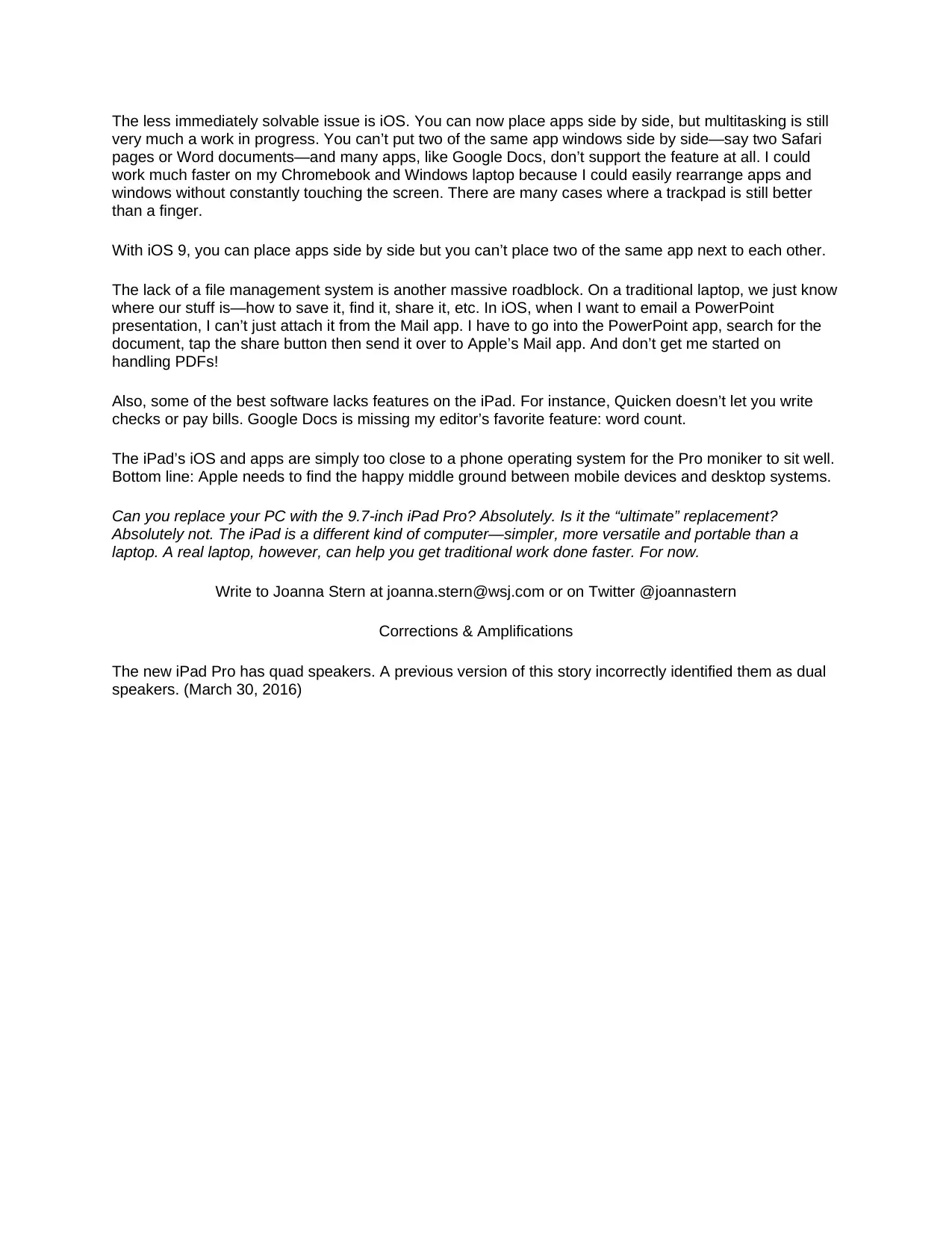
The less immediately solvable issue is iOS. You can now place apps side by side, but multitasking is still
very much a work in progress. You can’t put two of the same app windows side by side—say two Safari
pages or Word documents—and many apps, like Google Docs, don’t support the feature at all. I could
work much faster on my Chromebook and Windows laptop because I could easily rearrange apps and
windows without constantly touching the screen. There are many cases where a trackpad is still better
than a finger.
With iOS 9, you can place apps side by side but you can’t place two of the same app next to each other.
The lack of a file management system is another massive roadblock. On a traditional laptop, we just know
where our stuff is—how to save it, find it, share it, etc. In iOS, when I want to email a PowerPoint
presentation, I can’t just attach it from the Mail app. I have to go into the PowerPoint app, search for the
document, tap the share button then send it over to Apple’s Mail app. And don’t get me started on
handling PDFs!
Also, some of the best software lacks features on the iPad. For instance, Quicken doesn’t let you write
checks or pay bills. Google Docs is missing my editor’s favorite feature: word count.
The iPad’s iOS and apps are simply too close to a phone operating system for the Pro moniker to sit well.
Bottom line: Apple needs to find the happy middle ground between mobile devices and desktop systems.
Can you replace your PC with the 9.7-inch iPad Pro? Absolutely. Is it the “ultimate” replacement?
Absolutely not. The iPad is a different kind of computer—simpler, more versatile and portable than a
laptop. A real laptop, however, can help you get traditional work done faster. For now.
Write to Joanna Stern at joanna.stern@wsj.com or on Twitter @joannastern
Corrections & Amplifications
The new iPad Pro has quad speakers. A previous version of this story incorrectly identified them as dual
speakers. (March 30, 2016)
very much a work in progress. You can’t put two of the same app windows side by side—say two Safari
pages or Word documents—and many apps, like Google Docs, don’t support the feature at all. I could
work much faster on my Chromebook and Windows laptop because I could easily rearrange apps and
windows without constantly touching the screen. There are many cases where a trackpad is still better
than a finger.
With iOS 9, you can place apps side by side but you can’t place two of the same app next to each other.
The lack of a file management system is another massive roadblock. On a traditional laptop, we just know
where our stuff is—how to save it, find it, share it, etc. In iOS, when I want to email a PowerPoint
presentation, I can’t just attach it from the Mail app. I have to go into the PowerPoint app, search for the
document, tap the share button then send it over to Apple’s Mail app. And don’t get me started on
handling PDFs!
Also, some of the best software lacks features on the iPad. For instance, Quicken doesn’t let you write
checks or pay bills. Google Docs is missing my editor’s favorite feature: word count.
The iPad’s iOS and apps are simply too close to a phone operating system for the Pro moniker to sit well.
Bottom line: Apple needs to find the happy middle ground between mobile devices and desktop systems.
Can you replace your PC with the 9.7-inch iPad Pro? Absolutely. Is it the “ultimate” replacement?
Absolutely not. The iPad is a different kind of computer—simpler, more versatile and portable than a
laptop. A real laptop, however, can help you get traditional work done faster. For now.
Write to Joanna Stern at joanna.stern@wsj.com or on Twitter @joannastern
Corrections & Amplifications
The new iPad Pro has quad speakers. A previous version of this story incorrectly identified them as dual
speakers. (March 30, 2016)
1 out of 14
Related Documents
Your All-in-One AI-Powered Toolkit for Academic Success.
+13062052269
info@desklib.com
Available 24*7 on WhatsApp / Email
![[object Object]](/_next/static/media/star-bottom.7253800d.svg)
Unlock your academic potential
© 2024 | Zucol Services PVT LTD | All rights reserved.





